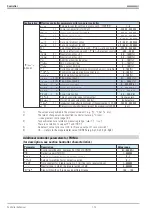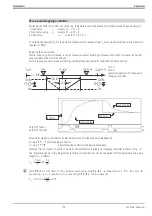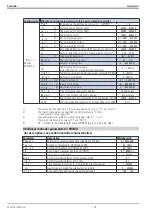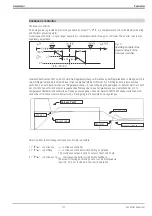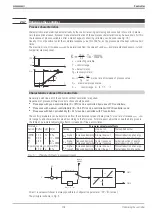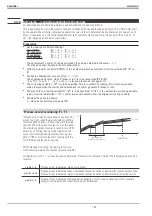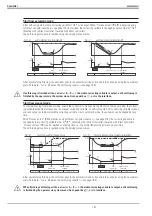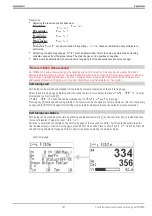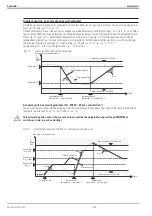
24.8
Self-tuning
r
controller adaptation to the process
For determination of optimal parameters a self-optimization can be accomplished.
This is applicable for controlled systems with reconciliation and none dominating dead time and K
≤
30%. After start
by the operator the controller initiates an adaptation cycle in order to determine the line characteristic values Tu and
Vmax. It calculates by it the control parameters for fast, overshoot-free correction to the set-point (Xp1, Xp2, Tn, Tv,
Tp1, Tp2, depending upon kind of controller).
Preparation
w
Set the desired controller behaviour
P-controller:
Tn
=
0.0
Tv
=
0.0
PD-controller:
Tn
=
0.0
Tv
>
0.0
PI-controller:
Tn
>
0.0
Tv
=
0.0
PID-controller:
Tn
>
0.0
Tv
>
0.0
The parameters Tn and/or Tv can be switched off, by being adjusted to the value =
0,0
.
Thus they do not participate in the self-optimization.
w
With the automatic controller CONTR+ is to be selected, which parameter set is to be optimized (
POpt
=1...
6).
w
Configure conditions for process at rest (
OCond
)
The condition designates, when "Prozess at rest" is to be recognized (
PIR_H
):
grad=0
,
grad<0/>0
or
grad0
(
r
also see process at rest, page 177).
w
The correcting variable
YOptm
is to be specified. This is, in automatic running, the correcting variable,
which is output with the start of self-optimization in order to generate "Prozess at rest".
w
The step of the correcting variable
dYopt
is to be specified.
dYopt
is the amount the correcting variable
jumps, from the initial value
YOptm
and/or in manual operation from the original correcting variable.
w
Consider the set-point reserve
(
r
also see set-point reserve, page 178)
‘Process-at-rest’ monitoring (
PiR
):
‘Process-at-rest’ monitoring is done at any time. The
proces is at rest, when the process value is within a
tolerance band of
_{
X = 0.5% during more than 60
seconds. When the process value is out of this band,
the monitoring timeout counter is reset to zero. With
detection of PiR e.g. during control operation and
output of a widely deviating stable correcting vari-
able
YOptm
at self-tuning start, waiting until the
full PiR time has elapsed is required.
With extended monitoring, monitoring is for a con-
stantly varying instead of a constant process variable!
Configuration word
OCond
can be used to determine ‘Process at rest’detection. One of the following modes can be
selected:
grad(x) = 0:
Process at rest is detected, when x is constant.
grad(x) <0/>0:
Process at rest is detected when x decreases constantly with a controller with inverse output action.
Process at rest is detected, when x increases constantly with a controller with direct output action.
grad(x) <> 0:
Process at rest is detected with constantly changing x. In this case, continuation of this constant
change over the duration of identification must be ensured.
Controller
9499 040 50611
Self-tuning
r
controller adaptation to the process
180
X
t
Zurücksetzen des
Überwachungszeitzählers
PiR
P
i R
( rozeß n uhe)
60s
{X = _0,5%
Summary of Contents for KS 98
Page 8: ...Description 9499 040 50611 Construction 8...
Page 10: ...Important technical data 9499 040 50611 Further external in and outputs 10...
Page 12: ...Versions 9499 040 50611 I O modules for units with modular option c basic card 12...
Page 14: ...Front view 9499 040 50611 14...
Page 16: ...Mounting 9499 040 50611 16...
Page 26: ...Maintenance 9499 040 50611 Further information 26...
Page 36: ...Scaling and calculating functions 9499 040 50611 LG10 10s logarithm 36...
Page 74: ...Signal converters 9499 040 50611 MEAN mean value formation 74...
Page 128: ...KS98 I O extensions with CANopen 9499 040 50611 RM_DMS strain gauge module 128...
Page 132: ...CSEND Send mod blockno s 21 23 25 27 No 57 132...
Page 140: ...Description of KS98 CAN bus extension 9499 040 50611 140...
Page 202: ...Controller 9499 040 50611 Process value calculation 202...







